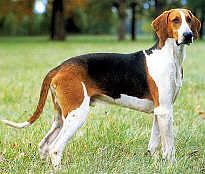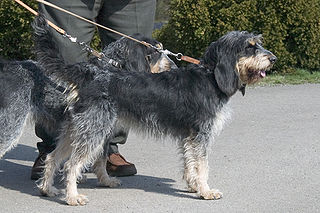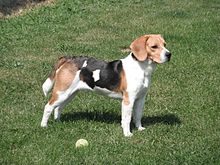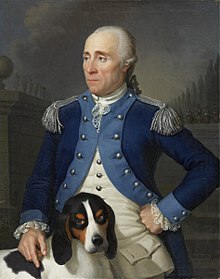
A hound is a type of hunting dog used by hunters to track or chase prey.

A coonhound, colloquially a coon dog, is a type of scenthound, a member of the hound group. They are an American type of hunting dog developed for the hunting of raccoons, hence their name, and also for feral pigs, bobcats, cougars, and bears. There are six distinct breeds of coonhound.

The Bluetick Coonhound is a breed of coonhound originating in the United States. The Bluetick Coonhound is known for its friendly personality, cold nose, and deep bawl mouth. It is most commonly used as a raccoon hunting dog, but may also be kept as a pet.

Griffon is a type of dog, a collection of breeds that were originally hunting dogs. There are three lines of the griffon type recognized by the Fédération Cynologique Internationale (FCI): the Griffon Vendéens, the wirehaired pointers, and the smousje. The griffon type is characterized by rough- or wire-hair.

The Basset Fauve de Bretagne is a short-legged hunting breed of dog of the scent hound type, originally from Brittany, a historical duchy of France.

The Grand Basset Griffon Vendéen or GBGV is a dog breed from France.

The Grand Bleu de Gascogne is a breed of hounds of the scenthound type, originating in France and used for hunting in packs. Today's breed is the descendant of a very old type of large hunting dog, and is an important breed in the ancestry of many other hounds.

The Petit Basset Griffon Vendéen, or PBGV, is a breed of dog of the scent hound type, bred to trail hares in bramble-filled terrain of the Vendée district of France. The breed is known in the United States as "Petit" or "PBGV," in England as "Roughie," and in Denmark as "Griffon" or "Petit". The PBGV is one of six types of "basset"-type breeds recognised by the Fédération Cynologique Internationale (FCI).

The Basset Bleu de Gascogne, also known as the Blue Gascony Basset, is a long-backed, short legged breed of dog of the hound type. A French native breed, it is rare outside its homeland. It is recognized internationally by the Fédération Cynologique Internationale, in the UK by The Kennel Club, and by the United Kennel Club in the United States. The "bleu" of its name is a reference to its coat which has a ticked appearance.

The Anglo-Français de Petite Vénerie is a medium-sized breed of dog used in hunting as a scenthound, usually in packs. It is one of the Anglo-French hound breeds which were created by crossing French scenthounds with English foxhounds. The name Petite Vénerie does not mean that dogs of the breed are petite or small, but rather that it is used to hunt small game.

The Basset Artésien Normand is a short legged hound type dog developed in France. The word basset refers to short-legged hounds.

Anglo-Français and Français hounds are a general dog type of hunting dog that include ancient French hounds and breeds created by mixing the French dogs with English (Anglo) Foxhounds. There are seven dog breeds that are described as Anglo-Français and Français hounds.

The Grand Anglo-Français Blanc et Noir translated into English as the Great Anglo-French White and Black Hound, is a breed of dog used in hunting as a scenthound, usually in packs. It is one of the Anglo-French hound breeds which were created by crossing French scenthounds with English (Anglo) Foxhounds.

The Grand Anglo-Français Blanc et Orange translated into English as the Great Anglo-French White and Orange Hound, is a breed of dog used in hunting as a scenthound, usually in packs. It is one of the Anglo-French hound breeds which were created by crossing French scenthounds with English (Anglo) foxhounds.

The Petit Bleu de Gascogne is a breed of dog of the scenthound type, originating in France and used for hunting in packs. Today's breed is the descendant of a large hunting dog. The Petit Bleu de Gascogne is not a small (petite) dog, the name comes from its use on small game.

The Griffon Bleu de Gascogne is a breed of dog of the scenthound type, originating in France, and is a versatile hunting dog, used on small and large game, in packs or individually. The Griffon Bleu de Gascogne has a speckled, rough coat.

The Griffon Nivernais is a breed of dog of the scenthound type, originating in France. It is a versatile hunting dog, used on small and large game, in packs or individually. Today's breed is a reconstruction of an ancient type of dog from the Nivernais region.

The Griffon Fauve de Bretagne is a breed of dog of the scenthound type, originating in France in the region of Brittany.

Bassets are a sub-type of scenthound deliberately bred with short legs, that are used for hunting where the hunters accompany the hunting hounds on foot.




















